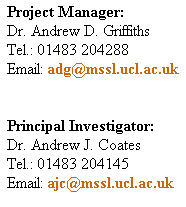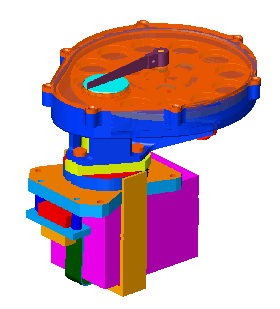



The two 'eyes' of Beagle 2 are known as the Stereo Camera System (SCS). One 'eye' is shown above. The SCS is provided by a team led by Andrew Coates (lead scientist) and Andrew Griffiths (project manager) of the Planetary Science Group at UCL's Mullard Space Science Laboratory. The SCS is the principal imaging experiment on the Beagle 2 lander. Beagle 2 will arrive on the surface of Mars on 25 December 2003 at 0254 GMT, following its transport to Mars with ESA's Mars Express orbiter (launch June 2, 2003). The first images from Mars, using the pop-up mirror, will appear soon afterwards.
The SCS consists of a pair of CCD cameras and optics, from Space-X (related to CSEM) in Switzerland, together with MSSL-UCL's contributions the filters, filter wheels and associated structure including a wiper blade to remove Martian dust (seen at top of the image above). The complete SCS system weighs just 350g.
Each camera has a set of 12 filters to enhance the science return. As well as several coloured filters, a close-up lens will provide the link between large scale SCS images and microscope images. A wide angle mirror enables images of the Martian surface to be taken soon after Beagle 2 lands and before robot arm deployment. Both SCS cameras are on Beagle 2's PAW (Position Adjustable Workbench).
The scientific objectives of the SCS include producing a Digital Elevation Model (DEM) and colour panoramas of the landing site from stereo image pairs. Additionally mineralogy and petrology of rocks at the landing site will be studied and atmospheric water vapour and dust opacity measured .
The SCS also provided vital mission engineering data in the form of the digital elevation model (DEM) which allows the robot arm to safely navigate the other instruments into place against target rocks and soils. A wide angle mirror (WAM) is used collect the first panoramic view of the landing site immediately after landing and to observe deployment and retraction of the mole. White light torches allow images to be acquired at night, without contamination due to red light scattered from dust in the atmosphere.
June 2006
Andrew Coates and Andrew Griffiths